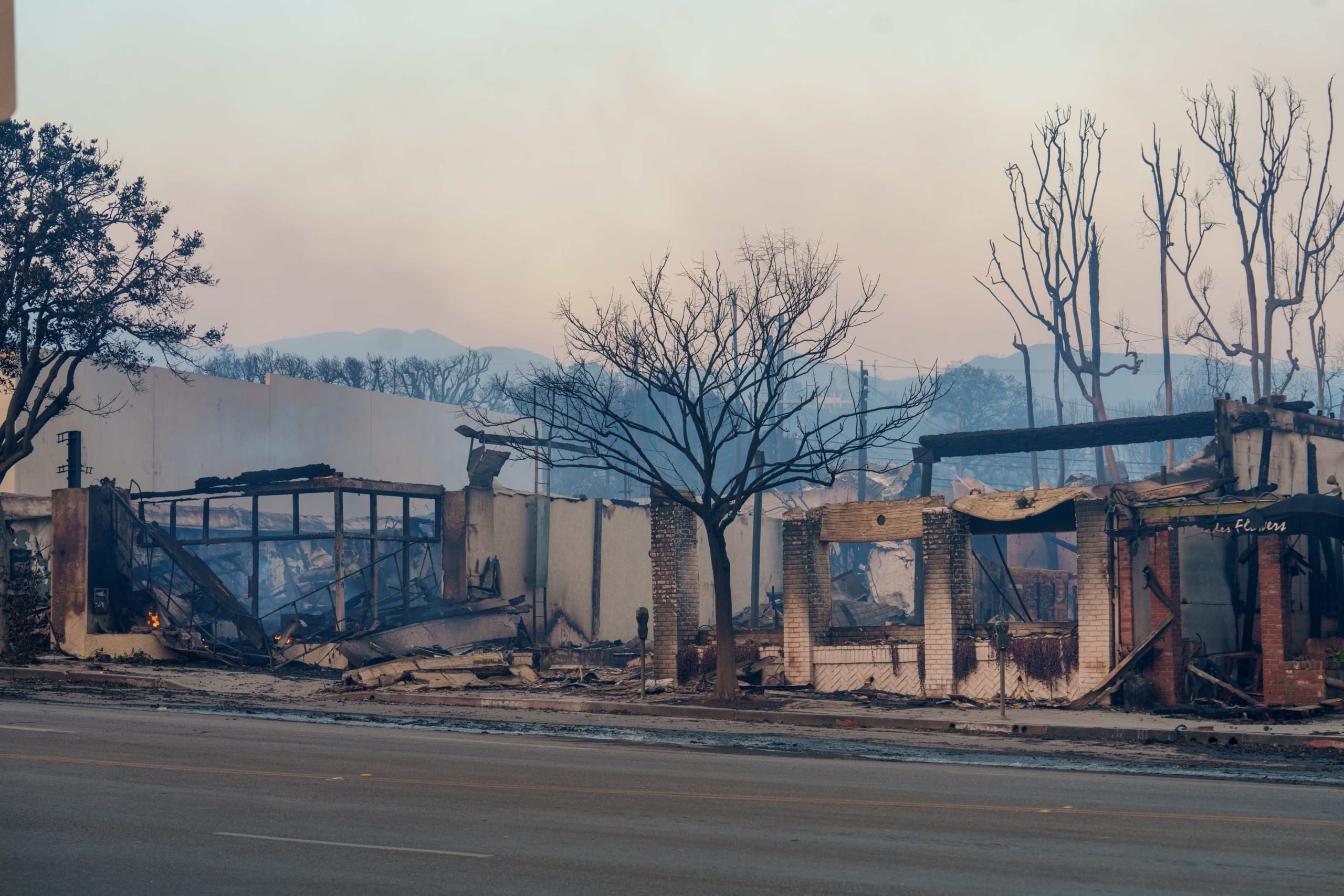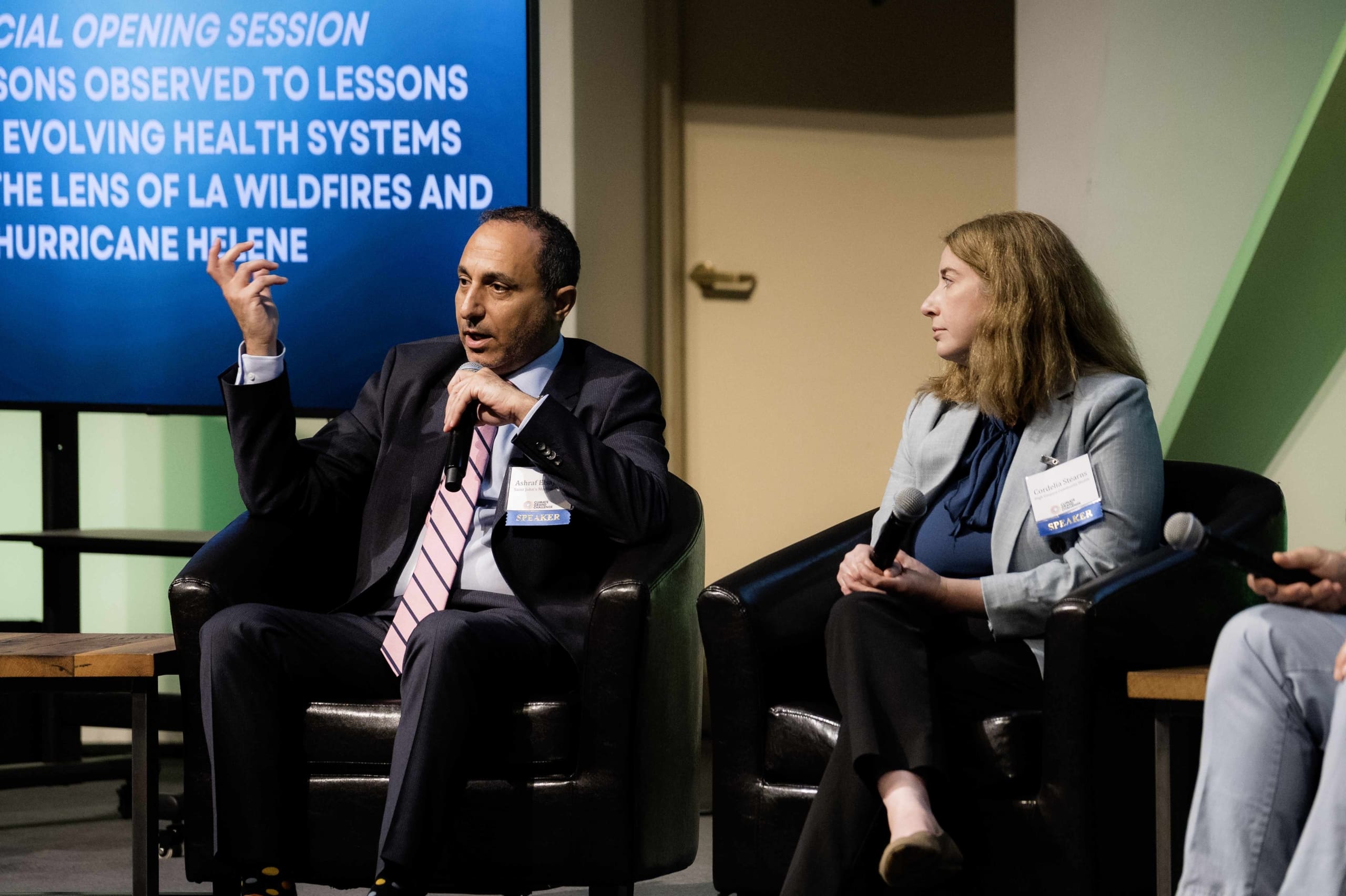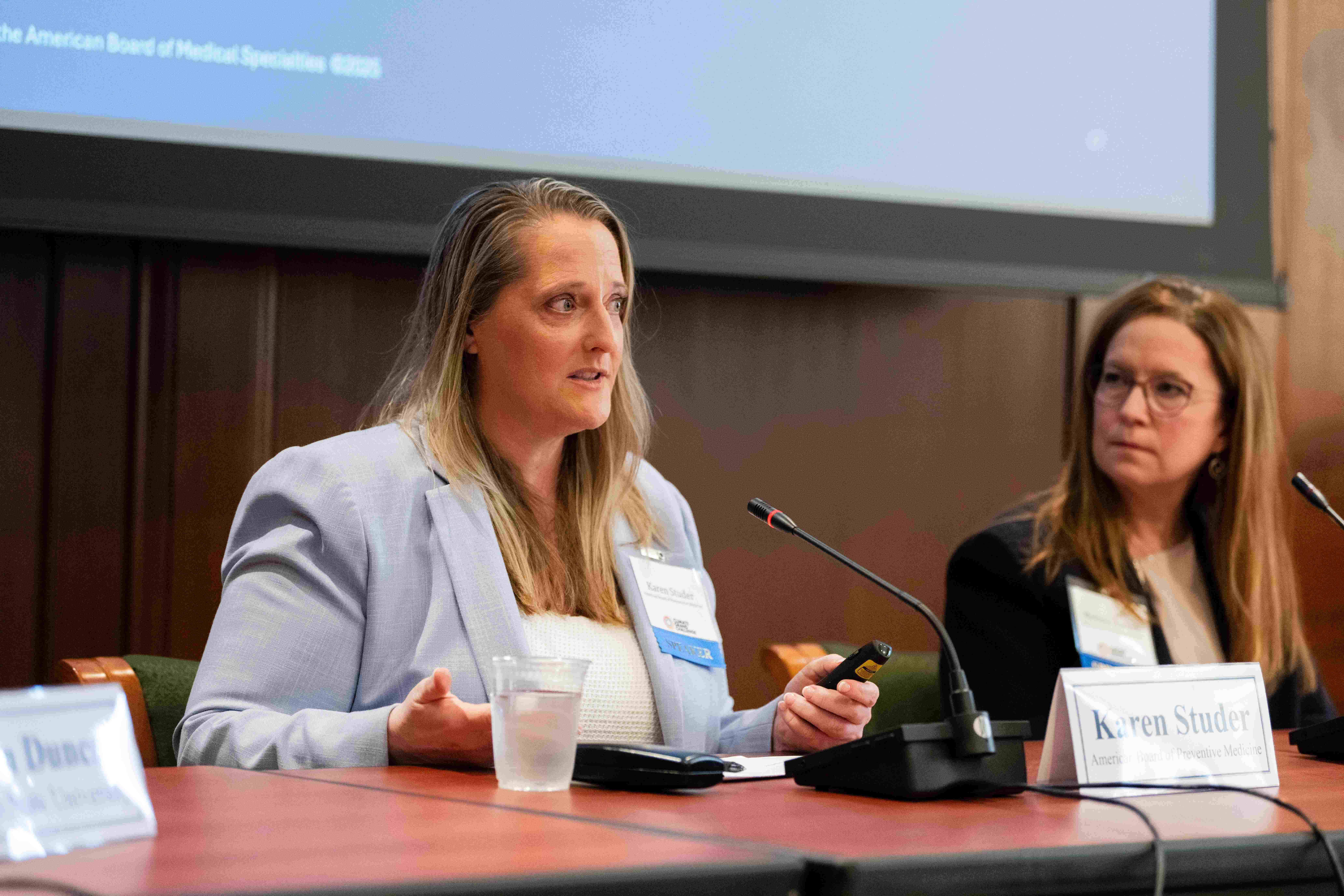
The January 2025 Palisades Fire caused widespread damage in Los Angeles County. Photo: Draco Guan via Shutterstock
By Jamie Durana
“I was personally in my backyard, saw the smoke, and the fire moved from four houses down to my backyard in about 22 seconds. When I went in and told my family we had to leave, it wasn’t, ‘Let’s pack and then evacuate.’ It was, ‘We are leaving this second.’”
Ashraf M. Elsayegh described the moments leading to the destruction of his family’s home during the devastating Palisades wildfire that burned close to 7,000 homes in Southern California early this year. The volatile organic compounds unleashed into the air as the fire burned thousands of mattresses and other home goods could have lasting health implications for residents who inhaled them. Elsayegh is a pulmonologist at Providence Saint John’s Health Center and his words brought into sharp focus the urgent reality of climate-related disasters during the National Academy of Medicine’s (NAM) second Climate and Health Summit in April.
The Palisades fire is not an isolated incident. As extreme weather events like wildfires and storms increase in frequency and intensity, health care systems and health professionals find themselves on the frontlines of interconnected challenges: weathering the damage to infrastructure wrought by climate-related disasters, treating the physical toll on patients, and confronting the systemic challenges the crises reveal. As climate impacts escalate, hospitals and health systems must adapt to better serve their communities in the face of extreme weather events and related public health threats.
On Earth Day 2025, the Summit brought together health care leaders, clinicians, community leaders, and other experts to discuss how to build climate-resilient health systems and communities, enhance disaster preparedness, and equip health professionals with the tools and communication skills necessary to lead. Their stories both sound the alarm and illustrate promising paths forward.
A Pressure Test: The Strain of Climate Disasters on Health Systems
On September 27, 2024, torrential rains turned into catastrophic floods overnight in western North Carolina. Cordelia Stearns of High Country Community Health needed to lead a response without power, internet, or phone lines. “It was pretty clear the rest of the country knew what a mess we were in before we did,” she said.
Despite the obstacles, staff managed to open five of High Country’s seven clinics. Social media became a sort of makeshift lifeline. “We posted some cell numbers for patients, and by far the most common call we got that first Monday morning was from patients who were out of their meds,” Stearns recalled. Some had lost medications to the floodwaters, others had to flee their homes with nothing.
For patients who use buprenorphine to treat opioid use disorder, Stearns knew the stakes were high because withdrawal could set in quickly. With pharmacies closed and roads impassable, Stearns said, “I had patients literally walk dozens of flooded mountain miles and swim across creeks to get their medication.”
The storm’s aftermath compounded health burdens. Respiratory issues surged due to dust and debris from the storm. “People became sick after cleaning contaminated water from their homes and wells,” Stearns said. For many residents, health care, including surgeries and care for chronic conditions, was delayed.
The loss of health care facilities dealt a blow to affected communities and caused ripple effects that could be felt across the country. Stearns described how one of High Country’s dental clinics was destroyed, with staff managing to continue operations from a tiny mobile trailer. “They’re the only dental providers serving Medicaid patients in their county, and they felt the need to be able to be there for patients right away,” she said. “But here we are, seven months in, and they’ve gone an entire mountain winter in this tiny setting serving patients with no end in sight.”

Ashraf M. Elsayegh (left) and Cordelia Stearns (right) speak at the Climate and Health Summit. Photo: Rodney Bailey
Floodwaters from Hurricane Helene swamped a Baxter Healthcare plant in Marion, North Carolina: one that supplies 60% of IV fluids used in the United States. Jason Stopyra of Advocate Health and Wake Forest University’s School of Medicine said the plant was hit with “an amazing force” powered by “19-foot swells of water and trillions of gallons” traveling at high speed. Stopyra described how Advocate Health turned its attention to addressing the disaster, including transporting patients and even facilitating organ donations. “We also deployed a major resource: Med One, a mobile hospital,” Stopyra said. “We set it up in a location that previously didn’t have a hospital, providing much-needed care.”
Navigating the IV fluid shortage was another challenge. Stopyra said it was critical to rethink the supply chain and reconsider how the fluid is used. “It forced us to become conscious about when and why we administer IV fluids. It’s almost automatic in the [emergency departments] — someone shows up, they get a bag,” he explained. “We had to pause and reconsider.” Advocate Health reduced IV fluid use by more than half during the initial disaster response, and Stopyra said they have maintained a 20% reduction. “It taught our physicians that maybe we don’t need to give IV fluids as often as we thought.”
Disasters like Hurricane Helene and the Palisades Fire deal an ongoing mental health burden. Both Elsayegh and Stearns described the impact of trauma on patients whose loved ones were lost, homes were destroyed, and lives upended in almost the blink of an eye. In the wake of disaster, media coverage and national or even international attention can spur action to handle the immediate crisis. But as Stearns cautioned, “the volunteers, the resources, the attention, it starts to fade away.” The changing climate is a defining force in health care delivery. Building and sustaining resilience requires long-term planning, a prepared workforce, and collaboration across the health sector.
Equipping the Workforce: Training Trusted Messengers
Preparedness is about more than infrastructure: it’s about people, and medical providers are among the most vital and trusted messengers of information. Across medical specialties, nursing, and veterinary care, among others, health professionals are recognizing the need to help patients and communities navigate the health impacts of a changing climate.
In emergency medicine, where critical issues often show up first, the connection between climate and health is being woven into core professional standards. “The emergency department is the safety net,” said Melissa Barton of the American Board of Emergency Medicine (ABEM). Addressing climate and health is at the forefront for emergency medicine professionals. “We provide a disproportionate amount of care for those who are most adversely impacted by climate change and that is why this topic is near and dear to our hearts,” she explained. Barton noted ABEM’s expanding certification model includes climate-relevant risks, like the spread of tick-borne illnesses such as Lyme disease in new regions due to warming temperatures. ABEM’s annual education modules are an opportunity to integrate emerging climate-related practice changes into recertification.
Karen Studer of the American Board of Preventive Medicine (ABPM) emphasized that the preventive medicine specialty trains doctors in environmental health, toxicology, and occupational hazards, like those faced by people who work outdoors. Studer sees opportunity for collaboration across specialties and proposed a new focused practice designation in climate and health as a way to “really work together because it looks like a lot of different specialties are interested in this topic.”

Karen Studer (left) and Melissa Barton (right) speak at the Climate and Health Summit. Photo: Vijay Iyer
Patricia Sharpnack of the National League for Nursing (NLN) Board of Governors said nurses are the largest and most trusted health care profession, making them uniquely positioned to communicate with the public about the relationship between climate and health outcomes. “We work across the continuum in all specialties, from primary care to advanced provider roles,” she said. “We can provide solutions that protect and promote well-being in the communities we serve.” Sharpnack noted that the NAM’s Future of Nursing 2020–2030 report calls for embedding climate preparedness into nursing education and disaster response training. She pointed to efforts underway, including an NLN Center of Excellence designation recognizing nursing schools advancing planetary health education and nursing accreditation bodies including climate competency.
Colleen Duncan of Colorado State University’s College of Veterinary Medicine and Biomedical Sciences reminded attendees that climate change also affects animal health and that animals can be part of the solution. Duncan described how veterinarians are trusted health messengers in their communities, especially in rural areas. She said that trust can be leveraged for climate communication. Duncan highlighted the American Association of Veterinary Medical Colleges’ climate change working group, which is developing guidance for integrating climate into core veterinary curricula. Areas of focus include disaster preparedness, reducing resource use in veterinary care, and public health collaboration around issues like rabies exposure, for example. Duncan called out Project Animal Aid, which can offer a second life for human medical equipment, as an example of building collaboration across the health sector to reduce environmental impact. Duncan said it’s important to “shake up” how we talk about health and emphasized that the human-animal bond can be powerful for driving change.
Making progress will mean overcoming the challenge of siloed efforts. “We’re working in silos,” Sharpnack said. “We need to collaborate more.” Training the workforce goes beyond preparing individual providers: it can connect professions, strengthen public trust, and accelerate solutions.
Breaking free from silos means ensuring that collaboration on climate action happens across all parts of the health sector. Several speakers pointed to the NAM’s Climate Journey Map, a resource designed to support health care suppliers and clinical stakeholders in efforts to address climate change by reducing greenhouse gas emissions, advancing sustainability, and strengthening resilience. Hardeep Singh of Baylor College of Medicine explained that reducing waste, like single-use plastics, is an area where there’s “unanimous agreement” across the sector. He emphasized that tools like the journey map can support faster uptake of proven sustainability strategies and suggested that health system boards can play a role in building accountability for progress.
The Health Sector’s Expanding Role
The discussions at the Summit illustrated how the health care sector is embracing a broader, more integrated role in responding to climate-related emergencies and to the underlying crisis itself. As wildfires force evacuations, floodwaters destroy critical infrastructure, and heat waves strain hospitals and urgent care clinics, health care must adapt and lead efforts to address the climate crisis.

Former Senator Bill Frist delivers remarks at the Climate and Health Summit. Photo: Vijay Iyer
In a climate-aware public health strategy, the credibility of health professionals is a powerful asset. From health centers mobilizing in the wake of catastrophic floods to health professionals stepping forward as trusted messengers, the health sector is strengthening care and advancing the training and communication needed to protect communities in a changing climate.
This dual role of responder and communicator requires coordination across the health care ecosystem — linking suppliers with sustainability strategies, certification boards with climate education, and frontline providers with public health planning. “We cannot approach this as a partisan issue,” said former Senator Bill Frist, underscoring the need for united action. “Planetary health is human health.”

